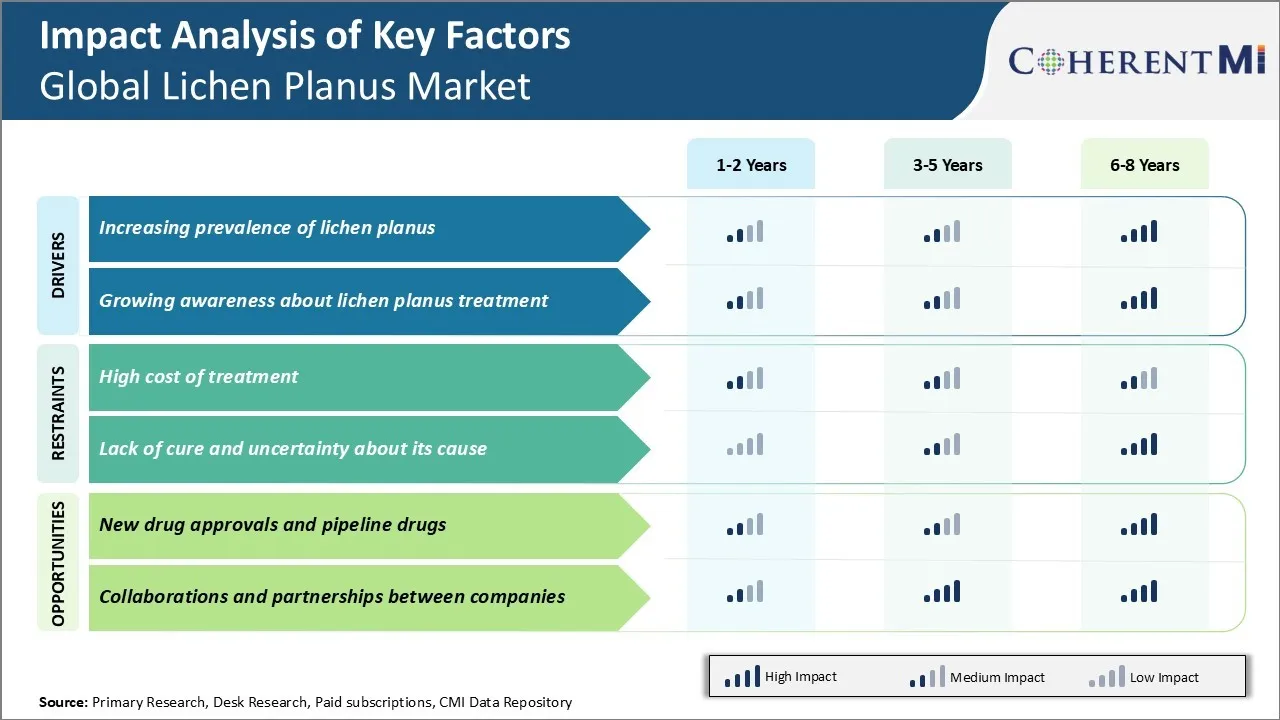Lichen Planus Market Trends
Market Driver - Increasing prevalence of lichen planus
One of the prominent drivers for the growth of the global lichen planus market is the rising prevalence of this inflammatory skin condition across various regions of the world. Lichen planus can affect people of any age group but is most frequently diagnosed in middle-aged individuals, especially those between 30-60 years of age. The exact causes behind its development are unknown but it has been seen linked to certain autoimmune conditions, viral infections, and oxidative stress. Studies show that the annual occurrence rates vary from less than 1% to over 2.6% across global populations.
The prevalence is found higher amongst people belonging to the Asian demographic compared to other ethnicities. Countries like India, Japan, China, and certain parts of the Middle East have reported sizable patient pools suffering from lichen planus over the years. Even developed regions in North America and Europe are witnessing an uptick in the patient numbers. A research survey conducted across 12 European nations estimated an average annual prevalence rate of over 0.22% among the adult inhabitants. With more public awareness and improved diagnostic capabilities, many such previously unreported cases are now being clinically identified.
Besides the natural aging and genetic factors that increase one's susceptibility, certain lifestyle behaviors are implicated as well. For example, consumption of tobacco and alcohol, excessive sun exposure, poor oral hygiene, dental amalgam fillings, and usage of certain medications like antihypertensives have demonstrated associations with lichen planus onset and exacerbation. With expanding urbanization and adaptations of unhealthy lifestyle habits on a global scale, it is expected that the disease prevalence will continue escalating in the future years unless corrective measures are taken. This growing patient base will surely drive greater demand for effective lichen planus treatment options like topical corticosteroids and retinoids in the worldwide market.
Growing awareness about lichen planus treatment
Another key driver for the global lichen planus industry is the rising awareness regarding the availability of various treatment methodologies and management approaches for this chronic condition. While there is no definitive cure, many different prescription medications and alternative therapies have proved useful in controlling symptoms, induction of remission, and improving patients' quality of life. Earlier, due to lack of understanding, lichen planus was often dismissed as a self-limiting skin problem with minimal implications. But now, more efforts are underway to educate people about its clinical significance and the importance of timely therapy initiation.
Various government agencies, dermatologists' associations, support groups, and pharmaceutical companies have taken initiatives to spread awareness through multiple channels. Information portals and web-based resources provide in-depth guidance on lichen planus causes, presentation patterns, available treatment options from topical corticosteroids to immunomodulators, expected outcomes, supportive self-care practices, signs to watch out for, and when to seek medical help. Public awareness programs are regularly conducted while print and visual mass media are also leveraged for creating awareness.
The empowered patients are no more hesitant to discuss their condition openly with doctors. They actively participate in treatment decisions and adherence. This has led to improved health seeking behavior. Even alternative medicine is gaining acceptance among some as adjunct orstandalone options. All such developments are encouraging appropriate clinical management of more patients worldwide. Greater awareness directly translates to increased product usage and market revenues over the coming years. Pharmaceutical manufacturers are reactively expanding their product portfolios and strengthening global distribution networks to tap into the unmet needs of this growing patient segment.

Market Challenge - High cost of treatment
The high cost of treatment poses a major challenge for the global lichen planus market. Lichen planus is a chronic inflammatory skin disease that causes itchy, scaly rashes on the skin, scalp, nails, and mucous membranes inside the mouth. Currently, treatment options for lichen planus include topical corticosteroids, topical calcineurin inhibitors, phototherapy, or systemic medications like corticosteroids or retinoids. However, these treatment options can be quite costly, especially for low and middle-income patients in developing countries where healthcare access and insurance coverage is limited. The expensive cost of medications and therapies makes long-term treatment unaffordable for many patients suffering from lichen planus. This high cost of treatment acts as a barrier to the growth of the global lichen planus market. Manufacturers will need to focus on developing more affordable generics and biosimilars to make treatment accessible to a wider population and drive market growth.
Market Opportunity- New Drug Approvals and Pipeline Drugs
The lichen planus market is expected to see significant opportunities due to the rising drug development pipeline and new product approvals. There is a growing focus on developing novel drugs with improved efficacy and safety profiles. For instance, in 2020, the US FDA approved a new topical calcineurin inhibitor called tacrolimus 0.1% ointment for the treatment of non-gonococcal anterior urethritis. Several pharmaceutical companies are conducting clinical trials for new drugs to target the underlying disease pathophysiology. Some pipeline drugs under investigation include JAK inhibitors, anti-TNF biologics, apremilast, and IL-17 inhibitors. The successful approval and launch of these new drugs will provide better treatment options, reduce side effects, and drive market revenues. Furthermore, an increase in R&D activities and investments is expected to yield more innovation, which presents significant growth prospects for key players in the global lichen planus market.